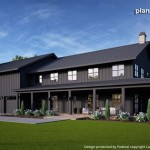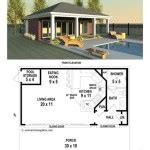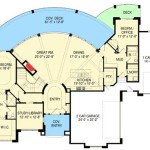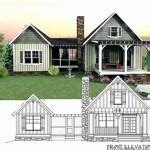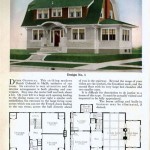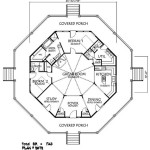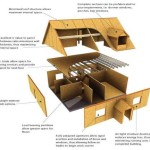An open house plan is a type of floor plan that features a large, open central space that encompasses the kitchen, dining room, and living room. This design is popular for its spaciousness, natural light, and flow of movement. One example of an open house plan can be found in the popular “Great Room” design, which features a grand, open living area that serves as the heart of the home, often with high ceilings and large windows.
Open house plans offer several advantages, including improved natural light due to fewer interior walls blocking windows, increased space and flexibility for furniture placement, and a more social and family-friendly atmosphere as the open layout encourages interaction and togetherness. However, there are also some potential drawbacks to consider, such as the lack of privacy between different areas of the home and the need for careful planning to ensure adequate storage and define separate spaces within the open layout.
In the following sections, we will explore the key features, benefits, and considerations of open house plans, providing insights into their suitability for different lifestyles and home designs.
Open house plans offer a range of notable advantages and key considerations.
- Spacious and airy
- Abundant natural light
- Free-flowing movement
- Social and family-friendly
- Improved space utilization
- Flexibility in furniture placement
- Reduced privacy between areas
- Potential noise issues
- Need for careful planning
By understanding these factors, homeowners can make informed decisions about whether an open house plan aligns with their lifestyle and design preferences.
Spacious and airy
Open house plans are renowned for their spacious and airy ambiance, achieved through the elimination of traditional walls separating different rooms. This expansive layout creates a sense of grandeur and openness, allowing for a free and uninhibited flow of movement throughout the central living space. The absence of constricting walls allows for the seamless integration of various functional areas, such as the kitchen, dining room, and living room, into a single, cohesive space.
The spaciousness of open house plans is further enhanced by the abundance of natural light that floods the central area through large windows and patio doors. The open layout allows for unobstructed sightlines, ensuring that natural light can penetrate deep into the home, illuminating even the farthest corners of the living space. This abundance of natural light not only creates a bright and inviting atmosphere but also reduces the need for artificial lighting, resulting in energy savings.
The airy quality of open house plans stems from the absence of physical barriers that can obstruct airflow. The open layout allows for a continuous circulation of air throughout the central living space, promoting a sense of freshness and vitality. The elimination of walls and the incorporation of high ceilings contribute to a more spacious and airy atmosphere, making the home feel larger and more inviting.
Overall, the spacious and airy nature of open house plans offers a range of benefits, including a sense of grandeur, improved natural light, and enhanced airflow. These factors contribute to a more comfortable and enjoyable living environment, making open house plans a popular choice for homeowners seeking a spacious and airy living space.
Abundant natural light
Open house plans are renowned for their abundance of natural light, a feature that significantly enhances the overall ambiance and well-being of the occupants. The open layout, characterized by the absence of traditional walls separating different rooms, allows for the free flow of natural light throughout the central living space. Large windows and patio doors strategically placed along the exterior walls maximize the entry of sunlight, creating a bright and inviting atmosphere.
The abundance of natural light in open house plans offers a range of benefits. Firstly, it reduces the reliance on artificial lighting, leading to energy savings. The ample natural light illuminates even the farthest corners of the living space, eliminating the need for additional lighting fixtures during the daytime. This not only reduces energy consumption but also contributes to a more sustainable and environmentally friendly home.
Secondly, natural light has a positive impact on the physical and mental well-being of occupants. Studies have shown that exposure to natural light can boost mood, increase productivity, and improve overall health. The bright and airy atmosphere created by the abundance of natural light in open house plans promotes a sense of well-being and vitality, making the home a more comfortable and enjoyable place to live.
Furthermore, natural light plays a crucial role in defining the spatial quality of open house plans. The interplay of light and shadow creates a dynamic and ever-changing environment, adding depth and character to the living space. The abundance of natural light highlights architectural features, such as high ceilings and exposed beams, accentuating the spaciousness and grandeur of the open layout.
In conclusion, the abundant natural light in open house plans is a key factor contributing to their popularity. The free flow of sunlight creates a bright and inviting atmosphere, reducing energy consumption and promoting well-being. Natural light also enhances the spatial quality of the home, adding depth and character to the open layout. Open house plans with ample natural light offer a superior living experience, making them a desirable choice for homeowners seeking a bright, healthy, and aesthetically pleasing living environment.
Free-flowing movement
Open house plans are designed to facilitate free-flowing movement throughout the central living space, creating a seamless and interconnected environment. The absence of traditional walls separating different rooms allows for uninterrupted transitions between the kitchen, dining room, and living room, promoting a sense of spaciousness and fluidity.
- Unrestricted movement: The open layout eliminates physical barriers, such as walls and doors, that can impede movement. This allows for effortless flow from one area to another, making it easy to navigate the living space and interact with others.
- Improved accessibility: Open house plans are particularly beneficial for individuals with mobility challenges or those seeking a more accessible living environment. The removal of walls and the incorporation of wider doorways and hallways ensure that all areas of the home are easily accessible, promoting independence and ease of movement.
- Enhanced social interaction: The free-flowing movement in open house plans encourages social interaction and fosters a sense of community among occupants. The open layout allows for easy communication and interaction between different areas, making it ideal for families and individuals who enjoy spending time together.
- Multi-functional spaces: The fluidity of movement in open house plans enables the creation of multi-functional spaces that can adapt to different needs and activities. For example, the kitchen island can serve as a breakfast bar, a food preparation area, and a casual dining space, maximizing the functionality of the central living area.
In summary, the free-flowing movement in open house plans offers a range of benefits, including unrestricted movement, improved accessibility, enhanced social interaction, and the creation of multi-functional spaces. This fluidity of movement contributes to a more comfortable, convenient, and enjoyable living experience, making open house plans a popular choice for homeowners seeking a spacious and interconnected living environment.
Social and family-friendly
Open house plans are renowned for their social and family-friendly nature, fostering a sense of togetherness and creating a welcoming environment for gatherings and family life.
- Encouraging interaction: The open layout promotes interaction and communication among family members and guests. The seamless flow of movement between different areas allows for easy mingling and conversation, creating a convivial atmosphere.
- Shared experiences: Open house plans facilitate shared experiences and activities. The central living space becomes a hub for family gatherings, movie nights, or casual meals, encouraging a sense of community and togetherness.
- Accommodating different needs: The flexibility of open house plans allows for the accommodation of different needs and preferences within the family. Multiple seating areas, for example, can cater to both adults and children, providing spaces for relaxation, play, or socialization.
- Enhanced supervision: Open house plans offer enhanced supervision for young children and elderly family members. The open layout allows parents or caregivers to keep an eye on their loved ones from various vantage points, providing peace of mind and a sense of security.
In summary, the social and family-friendly nature of open house plans makes them an ideal choice for homeowners seeking a home that fosters togetherness, encourages interaction, and accommodates the needs of all family members. The open layout creates a welcoming and convivial atmosphere, where families can connect, share experiences, and create lasting memories.
Improved space utilization
Open house plans are renowned for their efficient use of space, maximizing the functionality and livability of the home.
- Elimination of unnecessary walls: Open house plans eliminate unnecessary walls that separate different rooms, creating a more spacious and cohesive living area. The removal of walls allows for better space allocation and the creation of larger, more open spaces.
- Multi-functional spaces: The open layout enables the creation of multi-functional spaces that serve multiple purposes. For example, the kitchen island can double as a breakfast bar, food preparation area, and casual dining space, maximizing the functionality of the central living area.
- Flexible furniture placement: The absence of walls provides greater flexibility in furniture placement. Furniture can be arranged in various configurations to accommodate different needs and activities, allowing homeowners to customize the space to their liking.
- Improved flow of movement: The open layout facilitates a smooth flow of movement throughout the central living space. This eliminates bottlenecks and makes it easier to navigate the home, especially for individuals with mobility challenges.
In summary, open house plans offer improved space utilization through the elimination of unnecessary walls, the creation of multi-functional spaces, flexible furniture placement, and an improved flow of movement. These factors contribute to a more spacious, functional, and adaptable living environment, making open house plans a popular choice for homeowners seeking to maximize the use of their space.
Flexibility in furniture placement
Open house plans offer unparalleled flexibility in furniture placement, allowing homeowners to customize their living space to suit their unique needs and preferences.
- Unrestricted arrangements: The absence of walls separating different rooms allows furniture to be arranged in various configurations, unrestricted by traditional room boundaries. This flexibility enables homeowners to create customized layouts that maximize space utilization and cater to their specific lifestyle.
- Adaptability to changing needs: Open house plans can easily adapt to changing needs and preferences over time. Furniture can be rearranged to accommodate new additions, such as a growing family or a home office, without the constraints of fixed walls. This adaptability ensures that the living space remains functional and comfortable as circumstances evolve.
- Multi-functional spaces: The open layout facilitates the creation of multi-functional spaces that serve multiple purposes. For example, a sofa can be placed in the central living area to serve both as a seating area and a room divider, creating a more intimate and cozy space within the open plan.
- Improved flow of movement: The flexibility in furniture placement contributes to an improved flow of movement throughout the open house plan. Furniture can be arranged to create clear pathways and avoid obstructing movement, ensuring a smooth and effortless transition between different areas of the living space.
In summary, the flexibility in furniture placement offered by open house plans empowers homeowners to create customized and adaptable living spaces that meet their evolving needs and preferences. The ability to arrange furniture without the constraints of walls allows for maximum space utilization, multi-functional spaces, and an improved flow of movement, contributing to a more comfortable and enjoyable living environment.
Reduced privacy between areas
One potential drawback of open house plans is the reduced privacy between different areas of the home. The open layout, while promoting a sense of spaciousness and togetherness, can also make it difficult to find secluded spaces for private activities or conversations.
The lack of physical barriers between different areas means that activities and conversations in one area can easily be heard or observed from other parts of the home. This can be a concern for individuals who value privacy or require quiet spaces for work, study, or personal time. Open house plans may not be suitable for families with older children or teenagers who desire more independence and privacy.
Furthermore, the open layout can make it challenging to control lighting and temperature in different areas of the home. For example, if one person wants to watch a movie in the living room with dim lighting, it may be difficult to do so without affecting the lighting in the adjacent kitchen or dining area. Similarly, if one person wants to sleep in a bedroom while others are active in the central living space, noise and light from the common area can be disruptive.
To mitigate these privacy concerns, homeowners can employ various strategies. Strategic placement of furniture, such as bookcases or screens, can help to create visual barriers and define separate spaces within the open layout. Additionally, the use of curtains or blinds on windows and doors can provide privacy when needed. Sound-absorbing materials, such as rugs and upholstered furniture, can also help to reduce noise levels and improve privacy between different areas of the home.
In summary, while open house plans offer numerous benefits, the reduced privacy between different areas is a factor that potential homeowners should consider. By implementing thoughtful design strategies and utilizing privacy-enhancing elements, homeowners can mitigate these concerns and create a comfortable and functional living environment that balances openness and privacy.
Potential noise issues
Open house plans, with their expansive and interconnected spaces, can present potential noise issues that homeowners should consider. The absence of traditional walls separating different areas can allow noise to travel more easily throughout the home, affecting the privacy and comfort of occupants.
One of the main sources of noise in open house plans is the central living area, which often encompasses the kitchen, dining room, and living room. Activities such as cooking, entertaining guests, or watching television in this shared space can generate noise that can reverberate throughout the home. This can be particularly disruptive for individuals seeking quiet spaces for rest, study, or work.
Another potential source of noise in open house plans is the proximity of bedrooms to common areas. Without the sound insulation provided by walls, noise from the central living space or other active areas of the home can easily penetrate bedrooms, making it difficult for occupants to get a peaceful night’s sleep. This can be a significant concern for light sleepers or individuals who work night shifts and require daytime sleep.
Furthermore, the use of hard flooring materials, such as hardwood or tile, in open house plans can exacerbate noise issues. These materials reflect sound waves rather than absorbing them, leading to a louder and more reverberant acoustic environment. This can be particularly problematic in homes with high ceilings, as sound waves have more space to bounce around and amplify.
To mitigate potential noise issues in open house plans, homeowners can employ various strategies. The use of rugs and carpets can help to absorb sound and reduce reverberation. Strategic placement of furniture, bookshelves, or screens can also help to create physical barriers and deflect noise. Additionally, the installation of sound-absorbing materials, such as acoustic panels or curtains, can further reduce noise levels and improve acoustic privacy within the home.
Need for careful planning
Open house plans require careful planning to ensure that the space is functional, comfortable, and meets the needs of the occupants. Without proper planning, open house plans can lead to challenges such as lack of privacy, noise issues, and inefficient use of space.
- Defining separate spaces:
One of the key challenges in open house plans is defining separate spaces within the large, open area. Careful planning is required to create distinct zones for different activities, such as cooking, dining, living, and working. This can be achieved through the use of furniture, rugs, lighting, and other design elements to visually separate different areas while maintaining the sense of openness.
- Addressing privacy concerns:
The lack of traditional walls in open house plans can raise privacy concerns. Careful planning is needed to address these concerns and create private spaces for activities such as sleeping, working, or studying. This can be achieved through the use of room dividers, curtains, or strategic placement of furniture to create visual and acoustic barriers.
- Managing noise levels:
Open house plans can be prone to noise issues due to the lack of sound insulation between different areas. Careful planning is required to minimize noise levels and create a comfortable acoustic environment. This can be achieved through the use of sound-absorbing materials, such as carpets, rugs, and curtains, as well as strategic placement of furniture and other objects to deflect and absorb sound waves.
- Ensuring efficient use of space:
Open house plans offer the opportunity for efficient use of space, but careful planning is required to maximize functionality and avoid wasted space. This can be achieved through the use of multi-functional furniture, such as ottomans with built-in storage or sofa beds, as well as clever space-saving solutions, such as wall-mounted shelves and vertical storage.
By carefully considering these factors and implementing thoughtful planning strategies, homeowners can create open house plans that are both stylish and functional, meeting the needs of their lifestyle and ensuring a comfortable and enjoyable living environment.










Related Posts

